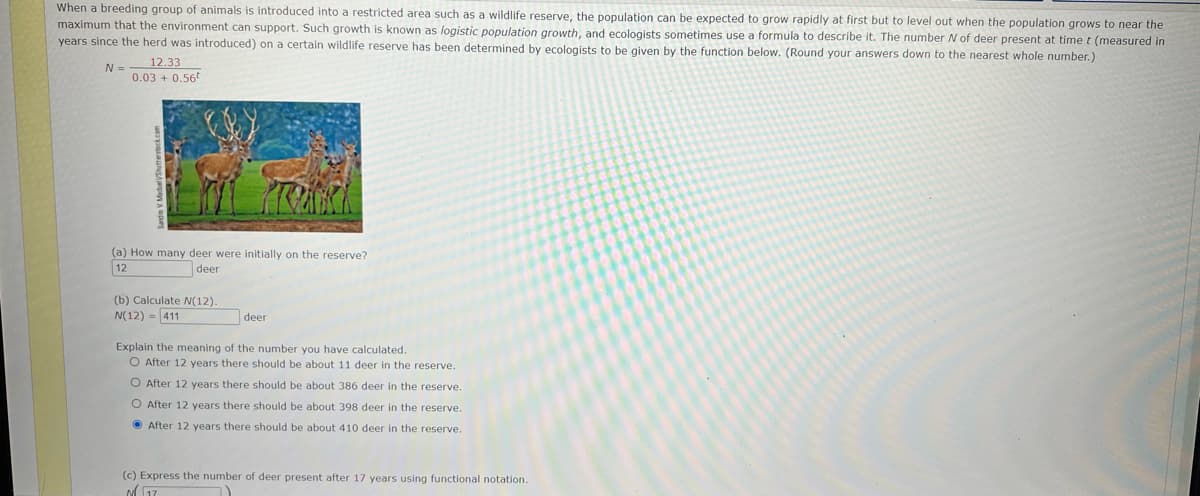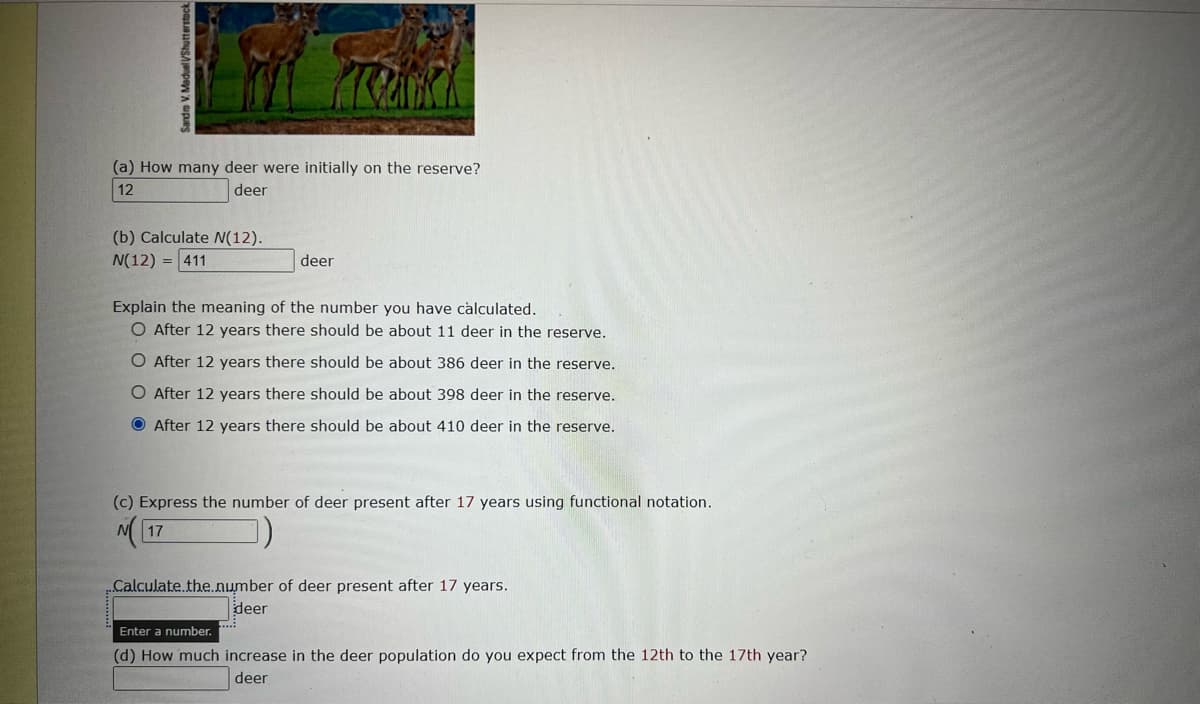When a breeding group of animals is introduced into a restricted area such as a wildlife reserve, the population can be expected to grow rapidly at first but to level out when the population grows to near the maximum that the environment can support. Such growth is known as logistic population growth, and ecologists sometimes use a formula to describe it. The number N of deer present at time t (measured in years since the herd was introduced) on a certain wildlife reserve has been determined by ecologists to be given by the function below. (Round your answers down to the nearest whole number.) 12.33 N = 0.03 + 0.56 (a) How many deer were initially on the reserve? 12 deer (b) Calculate N(12). N(12) = 411 deer Explain the meaning of the number you have calculated, O After 12 years there should be about 11 deer in the reserve. O After 12 years there should be about 386 deer in the reserve. O After 12 years there should be about 398 deer in the reserve. O After 12 years there should be about 410 deer in the reserve. (c) Express the number of deer present after 17 years using functional notation. M 17
When a breeding group of animals is introduced into a restricted area such as a wildlife reserve, the population can be expected to grow rapidly at first but to level out when the population grows to near the maximum that the environment can support. Such growth is known as logistic population growth, and ecologists sometimes use a formula to describe it. The number N of deer present at time t (measured in years since the herd was introduced) on a certain wildlife reserve has been determined by ecologists to be given by the function below. (Round your answers down to the nearest whole number.) 12.33 N = 0.03 + 0.56 (a) How many deer were initially on the reserve? 12 deer (b) Calculate N(12). N(12) = 411 deer Explain the meaning of the number you have calculated, O After 12 years there should be about 11 deer in the reserve. O After 12 years there should be about 386 deer in the reserve. O After 12 years there should be about 398 deer in the reserve. O After 12 years there should be about 410 deer in the reserve. (c) Express the number of deer present after 17 years using functional notation. M 17
Linear Algebra: A Modern Introduction
4th Edition
ISBN:9781285463247
Author:David Poole
Publisher:David Poole
Chapter6: Vector Spaces
Section6.7: Applications
Problem 16EQ
Related questions
Question

Transcribed Image Text:When a breeding group of animals is introduced into a restricted area such as a wildlife reserve, the population can be expected to grow rapidly at first but to level out when the population grows to near the
maximum that the environment can support. Such growth is known as logistic population growth, and ecologists sometimes use a formula to describe it. The number N of deer present at time t (measured in
years since the herd was introduced) on a certain wildlife reserve has been determined by ecologists to be given by the function below. (Round your answers down to the nearest whole number.)
12.33
N =
0.03 + 0.56
(a) How many deer were initially on the reserve?
12
deer
(b) Calculate N(12).
N(12) = 411
deer
Explain the meaning of the number you have calculated.
O After 12 years there should be about 11 deer in the reserve.
O After 12 years there should be about 386 deer in the reserve.
O After 12 years there should be about 398 deer in the reserve.
O After 12 years there should be about 410 deer in the reserve.
(c) Express the number of deer present after 17 years using functional notation.
M 17

Transcribed Image Text:(a) How many deer were initially on the reserve?
12
deer
(b) Calculate N(12).
N(12) = 411
deer
Explain the meaning of the number you have calculated.
O After 12 years there should be about 11 deer in the reserve.
O After 12 years there should be about 386 deer in the reserve.
O After 12 years there should be about 398 deer in the reserve.
O After 12 years there should be about 410 deer in the reserve.
(c) Express the number of deer present after 17 years using functional notation.
N 17
.Calculate the.number of deer present after 17 years.
deer
Enter a number.
(d) How much increase in the deer population do you expect from the 12th to the 17th year?
deer
Sando V. Maduel /Shutterstock
Expert Solution
This question has been solved!
Explore an expertly crafted, step-by-step solution for a thorough understanding of key concepts.
Step by step
Solved in 5 steps with 5 images

Recommended textbooks for you

Linear Algebra: A Modern Introduction
Algebra
ISBN:
9781285463247
Author:
David Poole
Publisher:
Cengage Learning


College Algebra (MindTap Course List)
Algebra
ISBN:
9781305652231
Author:
R. David Gustafson, Jeff Hughes
Publisher:
Cengage Learning

Linear Algebra: A Modern Introduction
Algebra
ISBN:
9781285463247
Author:
David Poole
Publisher:
Cengage Learning


College Algebra (MindTap Course List)
Algebra
ISBN:
9781305652231
Author:
R. David Gustafson, Jeff Hughes
Publisher:
Cengage Learning

Algebra & Trigonometry with Analytic Geometry
Algebra
ISBN:
9781133382119
Author:
Swokowski
Publisher:
Cengage